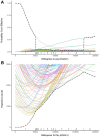Cost-Effectiveness of Surveillance Scanning Strategies after Curative Treatment of Non-Small-Cell Lung Cancer
- PMID: 33319646
- PMCID: PMC7879224
- DOI: 10.1177/0272989X20978167
Cost-Effectiveness of Surveillance Scanning Strategies after Curative Treatment of Non-Small-Cell Lung Cancer
Abstract
Background: After curative treatment of primary non-small-cell lung cancer (NSCLC), patients undergo intensive surveillance with the aim to detect recurrences from the primary tumor or metachronous second primary lung cancer as early as possible and improve overall survival. However, the benefit of surveillance is debated. Available evidence is of low quality and conflicting. Microsimulation modeling facilitates the exploration of the impact of different surveillance strategies and provides insight into the cost-effectiveness of surveillance.
Methods: A microsimulation model was used to simulate a range of computed tomography (CT)-based surveillance schedules, differing in the frequency and duration of CT surveillance. The impact on survival, quality-adjusted life-years, costs, and cost-effectiveness of each schedule was assessed.
Results: Ten of 108 strategies formed the cost-effectiveness frontier; that is, these were the strategies with the optimal cost-health benefit balance. Per person, the discounted QALYs of these strategies varied between 5.72 and 5.81 y, and discounted costs varied between €9892 and €19,259. Below a willingness-to-pay threshold of €50,000/QALY, no scanning is the preferred option. For a willingness-to-pay threshold of €80,000/QALY, surveillance scanning every 2 y starting 1 y after curative treatment becomes the best option, with €11,860 discounted costs and 5.76 discounted QALYs per person. The European Society for Medical Oncology guideline strategy was more expensive and less effective than several other strategies.
Conclusion: Model simulations suggest that limited CT surveillance scanning after the treatment of primary NSCLC is cost-effective, but the incremental health-benefit remains marginal. However, model simulations do suggest that the guideline strategy is not cost-effective.
Keywords: CT-scan; cost-effectiveness analysis; non-small cell lung-cancer; surveillance.
Conflict of interest statement
The authors declared no potential conflicts of interest with respect to the research, authorship, and/or publication of this article.
Figures



References
-
- Postmus PE, Kerr KM, Oudkerk M, et al. Early and locally advanced non-small-cell lung cancer (NSCLC): ESMO clinical practice guidelines for diagnosis, treatment and follow-up. Ann Oncol. 2017;28:iv1–iv21. - PubMed
-
- Colt HG, Murgu SD, Korst RJ, et al. Follow-up and surveillance of the patient with lung cancer after curative-intent therapy: diagnosis and management of lung cancer, 3rd ed: American College of Chest Physicians evidence-based clinical practice guidelines. Chest. 2013;143:e437S–54S. 2013/05/10. - PubMed
-
- Sause WT, Byhardt RW, Curran WJ, Jr., et al. Follow-up of non-small cell lung cancer. American College of Radiology. ACR Appropriateness Criteria. Radiology. 2000;215(suppl):1363–72. - PubMed
-
- Ettinger DS, Akerley W, Borghaei H, et al. Non-small cell lung cancer, version 2.2013. J Natl Compr Canc Netw. 2013;11:645–53. - PubMed
-
- Schneider BJ, Ismaila N, Aerts J, et al. Lung cancer surveillance after definitive curative-intent therapy: ASCO guideline. J Clin Oncol. 2019:JCO1902748. - PubMed
MeSH terms
LinkOut - more resources
Full Text Sources
Medical

